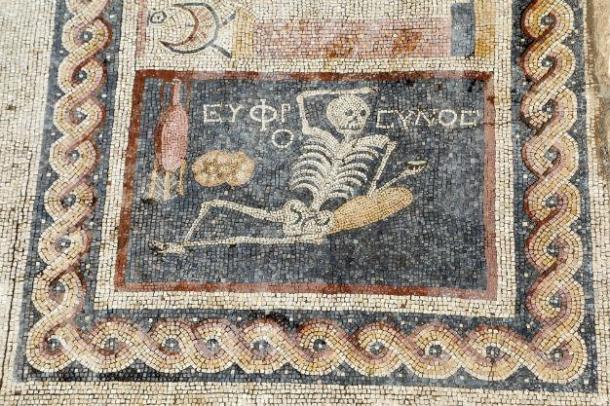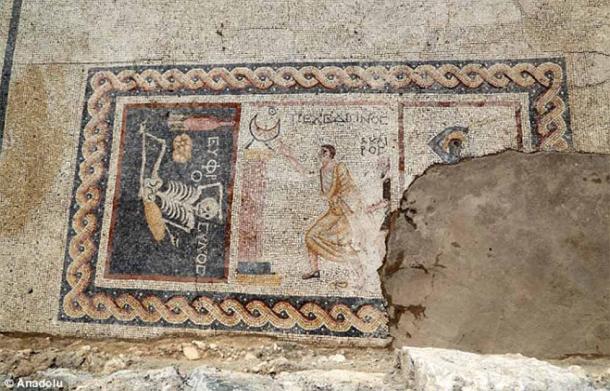
Take Heed Of The Jovial Roman Skeleton
We’re back in Turkey for the second time this week. Having told the story of the excavation of the oldest church in the world, now we are covering the ancient Roman “Jovial skeleton”.
Earlier this week we covered a story about a team of archaeologists from Turkey’s Hatay Archaeology Museum excavating the oldest church in the world. While I was researching this article, I came across details of another excavation by the same museum in 2016, which is quite relevant at this time of the year - a “jovial skeleton” mosaic!
A Most “Cheerful” Looking Skeleton
Not only is Hatay province home to the first church ever built, but the region is famed for its volume of Roman Period mosaics. Described as a “jovial artwork,” a particular mosaic was discovered in 2016 alongside the dining area of a contemporary house in Antiocheia city, the third largest in the world during the Roman period.
According to state-based Anadolu (news) Agency, the “cheerful looking skeleton” is casually holding a drink with a Greek inscription reading “Be cheerful, enjoy life.” We will get into what this mosaic means, but the skeleton is indicative of a sinister sense of humor, which the archaeologists say offers “a dash of hedonism” in the 3rd century BC.
- Crossing the Veil: The Pre-Christian Origins of Halloween and Samhain
- Tricking and Treating Has a Long History

The mosaic has been described as ‘jovial artwork’ (Anadolu Agency)
The Exceptional Jovial Skeleton
The so-called ‘jovial’ artwork was originally located within the dining area of a residence located in Antiocheia and it comprises three individual scenes made of black tiles on glass mosaics. Dr. Demet Kara, an archaeologist from the Hatay Archaeology Museum, said there “were mosaic schools and mints in the city of Antiocheia” during the Roman period.
The famous “Antioch mosaics” are a grouping of over 300 decorative floors created around the 3rd century AD. About half of these mosaics are now in the Hatay Archaeology Museum in Antakya, with the rest held in museums across the globe. Many of the Roman mosaics present scenes from day-to-day life and others display complex geometric patterns, and this is why the ‘cheerful’ skeleton stands out, as it belongs to neither group.
- This Scary Season: Halloween and Paranormal Phenomena Make for Supernatural Events
- Ex-Devil Worshipper Says: I'm Shocked Christians Celebrate Halloween

The full mosaic contains 3 pains with different scenes. (Anadolu Agency)
Adhering To Elite Schedules
Dr. Kara said that among elite classes during the Roman period bathing and dining were of paramount importance. In the first of the three scenes, a black person is depicted throwing fire, which symbolizes a slave heating bath water. The middle scene features a sundial and a young man running towards it being pursued by a butler. The sundial indicates the times 9 p.m. and 10 p.m., with the former being the traditional Roman bath time and the latter representing dinner time.
The butler is present to make sure the noble man gets to his bath and then dinner on time, for missing these times was regarded as a social offence. The last of the three scenes shows a “reckless skeleton” holding a drinking cup, bread and a wine pot, with the words “be cheerful and live your life.” This message is similar to the adage “Memento mori” (remember death) which was created by the philosophers of classical antiquity and Christianity as a reminder of the inevitability of death.
Being Remembered By History Was Everything in Ancient Rome
If you are a fan of history, you have no doubt asked yourself why the Romans, more so than any other ancient culture, were so bloodthirsty and obsessed with death. According to an article in The Collector many Romans believed that immortality “came from a person's presence living on in the hearts and minds of those they left behind.” This is reinforced within archaeology in the permanence of stone tombs featuring inscribed epitaphs which support the prolongation of life in the memories of those left behind after death.
Ancient Rome was peppered with the architecture of death, for example, the tomb of Marcus Vergilius Eurysaces, the baker and bread contractor, and his wife Atistia. Standing just outside the Porta Maggiore this grand monument of death was built around 30 BC. According to History Hit this huge 10 meter (33ft) high tomb is decorated with an elaborate frieze that depicts the various stages of bread making. Eurysaces was of Greek origin, and it is thought that the baker was most likely a wealthy freedman (ex-slave), and he probably instructed such a voluminous tomb so that after he died his monumental life achievement, of rising from low-born status to becoming an elite Roman, would be remembered in history.
Top image: The Roman skeleton mosaic at Antiocheia, Hatay, Turkey. Source: Anadolu Agency
By Ashley Cowie















